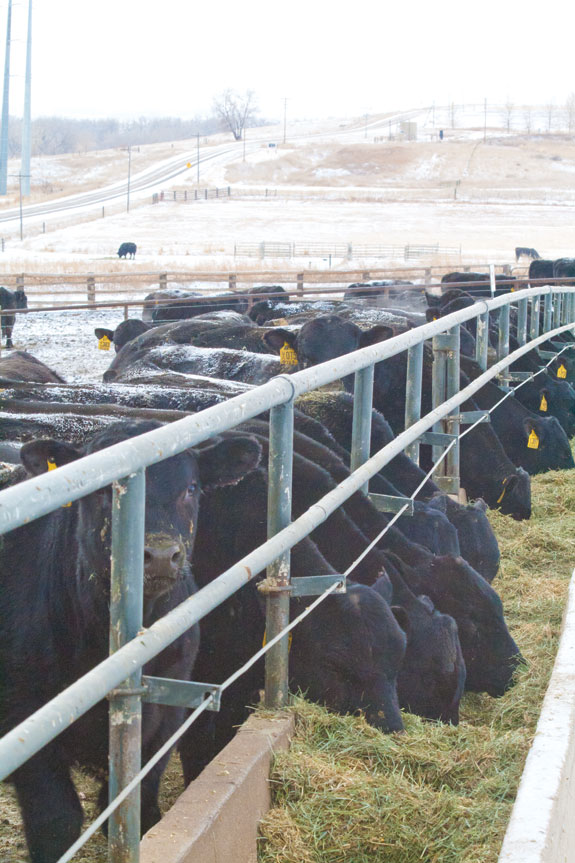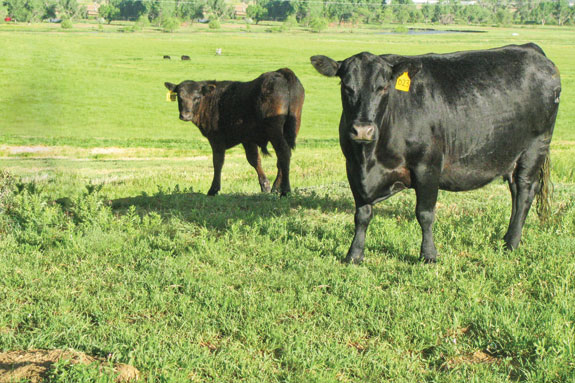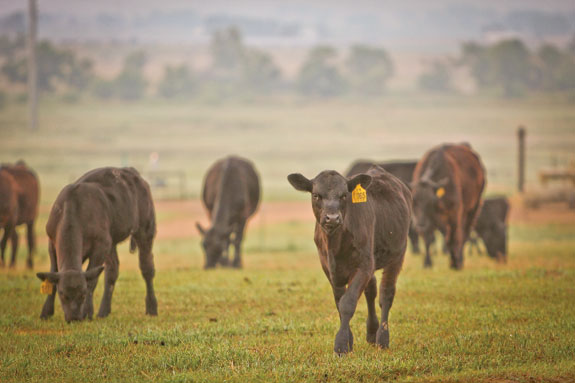The operation takes pride in a premier Angus bloodline that is charted and enhanced through three separate stages of production – seedstock, cow-calf and feedlot finishing.
Ben Houston and his wife, Nita, started the ranch after spending years in Angus production in sales and ranch management at other purebred operations.
Today their son Skylar is the company’s vice president, directing an array of modern production tools in a herd of 450 mothers and over 100 bulls.
By solidifying its selection practices during a period of steady growth for the Angus breed, Aristocrat has established its name at the forefront of domestic seedstock production.
Forefront of genetics
The ranch utilizes artificial insemination technology for all its reproductive genetics, along with some embryo transfer.
Aristocrat was a collaborative partner with teams at Colorado State University in the 1980s as sexed semen emerged in research studies.

Mark Gustafson, vice president of international sales at JBS Swift in Greeley, Colorado, said the Houston family’s approach has always included the most innovative genetic selection, from embryo transfer to thorough analysis of EPDs (expected progeny differences).
“They obviously had a good eye and knowledge of genetics and how to improve the quality of cattle and what to look for, the efficiencies and genetics that convert well,”
Gustafson said of the Houstons. “Ben and Skylar have always been at the forefront of any cattle technologies, first with embryo transfer and then the genetic programs to improve the herd.
“They don’t generally go for the big-framed cattle, but more for the quality and efficiency. They’ve always watched their genetics very closely.”
Aristocrat reviews all cattle phenotypes and conducts genetic defect testing and breeding soundness tests after they are weaned.
The key for Aristocrat at breeding time is to do thorough homework and find the right sire to match.
“We will go through and examine what we think are the best genetics we can get, and they don’t necessarily have to be our own,” Skylar Houston explained.
The operation backgrounds its calves and uses artificial insemination breeding in the spring, allowing the heifers to be basically the same age as bulls.
Houston says ranch workers apply proactive handling methods with their cattle, making them used to owners and their environment.
“We are pretty hands-on with our cattle,” Houston said. “We don’t look at them (only) three times a year.
They are looked at a lot and they are handled a lot. You know somebody can bring them into their operation and not worry about their temperament. That is an important thing.”
Peak-conditioned cattle
With its central location in the Rockies, Aristocrat caters to diverse regional buyers. Aristocrat’s genetic tools are especially useful for producers who need bulls rigorous enough to handle higher elevations, even up to 10,000 feet.

Aristocrat’s Platteville headquarters are around 5,000 feet, helping the cattle adapt to surrounding mountain climates.
A key marketing point for the cattle is the use of pulmonary arterial pressure test, or PAP, to measure their resistance against pulmonary arterial hypertension, which can lead to high mountain disease or brisket disease.
Cattle suffering from brisket disease experience pulmonary swelling due to a lack of oxygen and can die at higher altitudes if not relocated.
“This is a real big consideration for us selling cattle up into the mountains,” Houston explained. “What will happen is their brisket and their heart will swell up and you have to bring them down to a lower altitude.”
The PAP test is conducted on Aristocrat’s property. A vet inserts a catheter into the heart’s right atrium to register blood pressure and determine a score; a score in the 30s reflects excellent heart strength.
Anything more than a score of 40 means the animal won’t be strong enough to handle higher altitudes.
Tim Holt, an assistant professor of veterinary medicine at Colorado State University, has conducted key research on the disease and works with Aristocrat on its testing protocols.
Most tests concentrate on the bull, Holt said, because their impact is so big on the herd. “But if you have producers in Gunnison, Walden or Steamboat Springs, those are at 6,000 to 7,000 feet, and a lot of people will want one on the female, so they know they have a clean herd through maternal lines.
“Skylar doesn’t have to do that too much because he doesn’t spend as much time in high elevations – so he concentrates on giving a good bull.”
Demand has been high among seedstock producers in the region to test bulls and even some heifers to determine PAP strength, especially since no EPD has emerged for brisket disease performance.
“It’s in a lot of different breeds, or animals, and I have yet to find any breed that doesn’t have a high score,” Holt said. “All cattle seem to be affected by altitude stress.”
Premiums from Angus
Due to high demand for calves, Aristocrat didn’t feed out its cattle this year. But when feed prices are efficient, cattle raised at Aristocrat are finished on-site with a targeted three pounds of average daily gain. Ration formulas use ground hay, silage, dry distillers grain, cracked corn and a liquid supplement.
Steers enter the feedlot at about 600 pounds around the first of November and are looking to finish at 1,230 pounds by June.

Premiums are made through cattle meeting the specifications of Certified Angus Beef and also by sending steers to a local kosher slaughter plant.
“We are trying to have our bulls meet the requirements as much as possible,” Houston said of CAB. He says utilizing ultrasounds to inspect back fat, ribeye and marbling all help balance the approach on carcass data.
“That is a large part of our breeding decisions, basing selection on those parameters. The yearling heifers and the bulls, we find out the information on them. That is equated to beef value and that will determine from that sire how their beef value is going.”
Gustafson said although the Aristocrat operation isn’t a huge operation, its ability to track genetic performance from calving through the finishing stages is what yields exceptional results in performance.
“At the end of the day, when we buy the Aristocrat and Houston cattle, they’re 70 to 80 percent choice, 10 to 12 (percent) prime, where the industry average is around 3, and at about 80 percent CAB.
“If the industry could ever hit their levels in the carcass data, we wouldn’t have any of the problems we see,” he said. “They know how to do it right.”
In the middle of it all
Being close to an urban center like Denver, Aristocrat Angus finds itself hosting guests routinely – from export trade groups to chefs and foodies curious about beef production.
“I think people see it as an important component,” Houston said of the tours he conducts regularly.
“We are not on an island out here. We’ve got to communicate with people and I guess that’s more of what we do … We help show the story of what we do to give a good story for the industry.”
The same personal approach can be found in bull sales. Aristocrat primarily has used private treaty sales on its bulls and females, with some uses of video auction sales.
Aristocrat works with customers on their expressed bull specifications and building trust that lends to establishing a return buyer.
“They have got to be what you tell them it is, or they won’t be back,” Houston said.
Gustafson praised the ranch for its broad and strong interest in the beef industry. With cow-calf producers watching primarily until the calf leaves, feeders keeping the eye on the average and packers watching the carcass weights – it’s impressive to him when an operation keeps a hand in all segments.
“They really take a strong interest … in all facets of the industry, trying to build tools to help people get better results.” ![]()
PHOTOS
TOP: The cattle at Aristocrat are worked regularly by crews to help their temperament. Photo courtesy of Aristocrat Angus
TOP MIDDLE: When feeding after November at Aristocrat Angus, cattle are targeted to gain an average of three pounds daily. Photo courtesy of Staff
BOTTOM MIDDLE: Aristocrat has 450 mother Angus cows and over 100 bulls. The operation owns and leases grazing lands surrounding the reproduction center and feedlot. Photo courtesy of Aristocrat Angus
BOTTOM: Once Aristocrat bull calves mature, they are routinely tested for pulmonary arterial hypertension (PAP) scores in the high altitude near Denver. Photo courtesy of Aristocrat Angus






